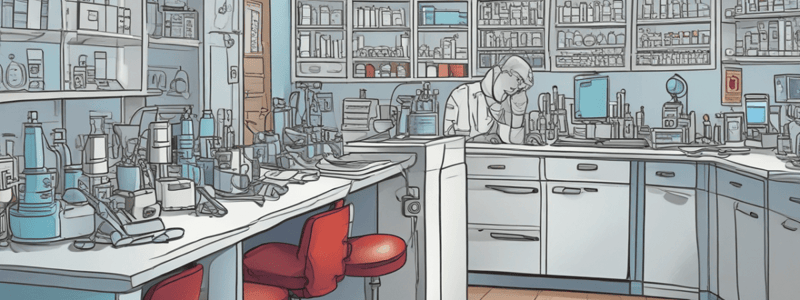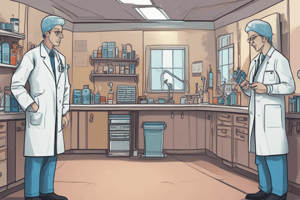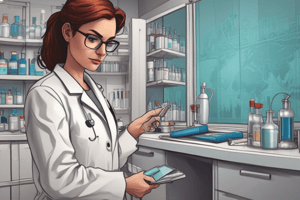Podcast
Questions and Answers
What is the primary purpose of discussing the procedure with the patient during phlebotomy?
What is the primary purpose of discussing the procedure with the patient during phlebotomy?
- To inspect the patient's arm for visible veins
- To confirm the patient's identity
- To obtain informed consent and reduce anxiety (correct)
- To ensure the patient's vein is accessible
Which of the following veins is commonly used for phlebotomy?
Which of the following veins is commonly used for phlebotomy?
- Median basilic vein
- Antecubital fossa
- Cephalic vein
- All of the above (correct)
What is the recommended angle for inserting the needle during phlebotomy?
What is the recommended angle for inserting the needle during phlebotomy?
- 15-degree angle
- 30-degree angle (correct)
- 45-degree angle
- 90-degree angle
What is the primary function of a tourniquet in phlebotomy?
What is the primary function of a tourniquet in phlebotomy?
What is a common symptom of renal failure?
What is a common symptom of renal failure?
What is the primary characteristic of kidney stones?
What is the primary characteristic of kidney stones?
What is the primary symptom of a urinary tract infection (UTI)?
What is the primary symptom of a urinary tract infection (UTI)?
What is the primary characteristic of diabetes?
What is the primary characteristic of diabetes?
What is an essential step in the phlebotomy process?
What is an essential step in the phlebotomy process?
What is the final step in the phlebotomy process?
What is the final step in the phlebotomy process?
What is a possible indication of high levels of blood acids in a patient's blood test results?
What is a possible indication of high levels of blood acids in a patient's blood test results?
What is a common symptom of urinary tract infections in pregnant women?
What is a common symptom of urinary tract infections in pregnant women?
What is the term for the lower chambers of the heart that pump blood out of the heart?
What is the term for the lower chambers of the heart that pump blood out of the heart?
What is the function of the kidneys in the urinary system?
What is the function of the kidneys in the urinary system?
What is the term for a genetic disorder that impairs blood clotting?
What is the term for a genetic disorder that impairs blood clotting?
What is the correct pathway of blood through the circulatory system?
What is the correct pathway of blood through the circulatory system?
What is the term for a blood vessel getting smaller in diameter?
What is the term for a blood vessel getting smaller in diameter?
What is the term for white blood cells?
What is the term for white blood cells?
What is the term for a condition characterized by decreased red blood cell count or hemoglobin levels?
What is the term for a condition characterized by decreased red blood cell count or hemoglobin levels?
What is the term for a hard deposit formed in the kidneys?
What is the term for a hard deposit formed in the kidneys?
What is the shape of a red blood cell?
What is the shape of a red blood cell?
What is the function of one-way valves in veins?
What is the function of one-way valves in veins?
What is the primary site of destruction for aged red blood cells?
What is the primary site of destruction for aged red blood cells?
What mineral is necessary for normal hemoglobin production?
What mineral is necessary for normal hemoglobin production?
What does hemoglobin carry in red blood cells?
What does hemoglobin carry in red blood cells?
What type of blood flows through the pulmonary arteries?
What type of blood flows through the pulmonary arteries?
What does a dark yellow color of urine indicate?
What does a dark yellow color of urine indicate?
What does a fruity odor of urine indicate?
What does a fruity odor of urine indicate?
What does cloudy urine indicate?
What does cloudy urine indicate?
What does the blood transport?
What does the blood transport?
What is the primary function of the atria in the heart?
What is the primary function of the atria in the heart?
What is the term for the condition characterized by the buildup of plaque in the arteries?
What is the term for the condition characterized by the buildup of plaque in the arteries?
What is the primary function of the kidneys in the urinary system?
What is the primary function of the kidneys in the urinary system?
What is the term for the presence of high levels of blood acids in a patient's blood test results?
What is the term for the presence of high levels of blood acids in a patient's blood test results?
What is the primary function of the capillaries in the circulatory system?
What is the primary function of the capillaries in the circulatory system?
What is the term for a bacterial infection in the urinary system?
What is the term for a bacterial infection in the urinary system?
What is the primary role of a clinical laboratory technician?
What is the primary role of a clinical laboratory technician?
What is the term for the presence of glucose in a patient's urine?
What is the term for the presence of glucose in a patient's urine?
What is the primary function of the ureters in the urinary system?
What is the primary function of the ureters in the urinary system?
What is the term for the cancer of the blood-forming tissues, including bone marrow?
What is the term for the cancer of the blood-forming tissues, including bone marrow?
What is the primary reason for discussing the procedure with the patient during phlebotomy?
What is the primary reason for discussing the procedure with the patient during phlebotomy?
What is the typical vein used for phlebotomy?
What is the typical vein used for phlebotomy?
What is the primary function of a radiologist?
What is the primary function of a radiologist?
What is the term for a blood vessel getting smaller in diameter?
What is the term for a blood vessel getting smaller in diameter?
What is the purpose of using a tourniquet during phlebotomy?
What is the purpose of using a tourniquet during phlebotomy?
What is a common symptom of kidney stones?
What is a common symptom of kidney stones?
What is the normal percentage of hematocrit levels in the blood?
What is the normal percentage of hematocrit levels in the blood?
What is the final step in the phlebotomy process?
What is the final step in the phlebotomy process?
What is the term for a Red Blood Cell?
What is the term for a Red Blood Cell?
What is the primary characteristic of renal failure?
What is the primary characteristic of renal failure?
What is the primary function of plasma in the blood?
What is the primary function of plasma in the blood?
What is the primary characteristic of diabetes?
What is the primary characteristic of diabetes?
What does a pale yellow color of urine indicate?
What does a pale yellow color of urine indicate?
What is the recommended angle for inserting the needle during phlebotomy?
What is the recommended angle for inserting the needle during phlebotomy?
What is the term for a White Blood Cell?
What is the term for a White Blood Cell?
What is the purpose of cleaning the area with an alcohol wipe during phlebotomy?
What is the purpose of cleaning the area with an alcohol wipe during phlebotomy?
What is the term for a condition characterized by a low red blood cell count or hemoglobin levels?
What is the term for a condition characterized by a low red blood cell count or hemoglobin levels?
What is a common symptom of urinary tract infections (UTIs)?
What is a common symptom of urinary tract infections (UTIs)?
What is the primary function of the atria in the heart?
What is the primary function of the atria in the heart?
What is the primary function of the spleen and liver in the circulatory system?
What is the primary function of the spleen and liver in the circulatory system?
Flashcards are hidden until you start studying
Study Notes
Phlebotomy Steps
- Discuss with the patient what you will be doing and why, confirming patient name and tests being drawn.
- Identify the vein to be used, commonly the antecubital fossa, median cephalic, or median basilic veins.
- Gather needed supplies, perform proper hand washing techniques, and put on gloves.
- Place a tourniquet and clean the area for 30 seconds with an alcohol wipe.
- Insert the beveled needle at a 30-degree angle into the vessel, connecting vacutainers or using a syringe to drawback.
- Properly label the tubes and send them to the laboratory for analysis.
- Clean up space, ensuring all sharps are placed in a properly labeled sharps container.
Career Profiles
- Clinical Laboratory Technician: conducts laboratory tests, prepares specimens, analyzes results, and reports findings to medical staff.
- Pharmacist: dispenses medications, provides patient education, and reviews prescriptions for accuracy and potential drug interactions.
- Pharmacy Technician: assists pharmacists, processes prescriptions, labels medication, and handles customer inquiries.
- Phlebotomist: collects blood samples, ensures proper labeling and handling of specimens, and adheres to safety protocols.
- Radiologist: interprets medical images, provides diagnostic reports, and requires extensive medical training and expertise in diagnostic imaging.
- Radiographer: operates imaging equipment, positions patients correctly, and ensures image quality.
Urinary System
- Kidneys: filter waste from blood, regulate electrolyte balance and blood pressure.
- Ureters: transport urine from kidneys to the bladder.
- Bladder: stores urine.
- Urethra: tube through which urine exits the body.
- Conditions:
- Urinary Tract Infection (UTI): bacterial infection in the urinary tract.
- Kidney Stones: hard deposits formed in the kidneys from minerals and salts.
- Renal Failure: decreased kidney function leading to waste buildup in the body.
Circulation and Body Defense
- Anatomy of the Heart:
- Atria: upper chambers of the heart receiving blood.
- Ventricles: lower chambers pumping blood out of the heart.
- Blood Vessels:
- Arteries: carry oxygen-rich blood away from the heart.
- Veins: return oxygen-depleted blood to the heart.
- Capillaries: tiny blood vessels where gas exchange occurs.
- Blood:
- Plasma: liquid portion of blood containing water, proteins, and other solutes.
- Cells: red blood cells (RBCs), white blood cells (WBCs), and platelets.
- Conditions:
- Anemia: decreased red blood cell count or hemoglobin levels.
- Leukemia: cancer of the blood-forming tissues, including bone marrow.
- Hemophilia: genetic disorder impairing blood clotting.
- Sickle Cell Anemia: inherited disorder causing abnormal hemoglobin production.
- Atherosclerosis: buildup of plaque in the arteries, narrowing blood flow.
Diagnostic Factors
- Ketones: high levels of blood acids, indicating increased fat metabolism, potentially due to diabetes or fasting.
- Proteins: presence in urine may indicate kidney damage or disease, dehydration, infection, or certain medications.
- Glucose: presence in urine may indicate high blood sugar levels, often seen in uncontrolled diabetes.
- hCG (Human Chorionic Gonadotropin): presence indicates pregnancy, used in pregnancy tests to detect early signs of pregnancy.
- Patient History: provides insights into past medical conditions, medications, lifestyle habits, and family history.
- Vital Signs: blood pressure, heart rate, respiratory rate, and temperature, which may indicate systemic issues or organ dysfunction.
- Color and Odor: changes in urine can provide clues about hydration levels, dietary habits, and certain medical conditions.
Blood
- Composition: 45% blood to 55% plasma.
- Erythrocyte (Red Blood Cell): biconcave shape.
- Leukocyte (White Blood Cell): part of the immune system.
- Thrombocyte (Platelet): involved in blood clotting.
- Hemoglobin: carries oxygen in red blood cells, an oxygen transporter, and a pigment in blood.
- Hematocrit levels: 45% blood to 55% plasma.
Urine Analysis
- Color:
- Dark yellow: dehydration.
- Pale light yellow: hydration.
- Orange/Red: blood in the urine (hematuria).
- Odor:
- Fruity: presence of ketones.
- Foul: presence of bacteria.
- Transparency:
- Clear: normal urine samples.
- Cloudy: potential UTI or presence of blood cells or pus.
Studying That Suits You
Use AI to generate personalized quizzes and flashcards to suit your learning preferences.




